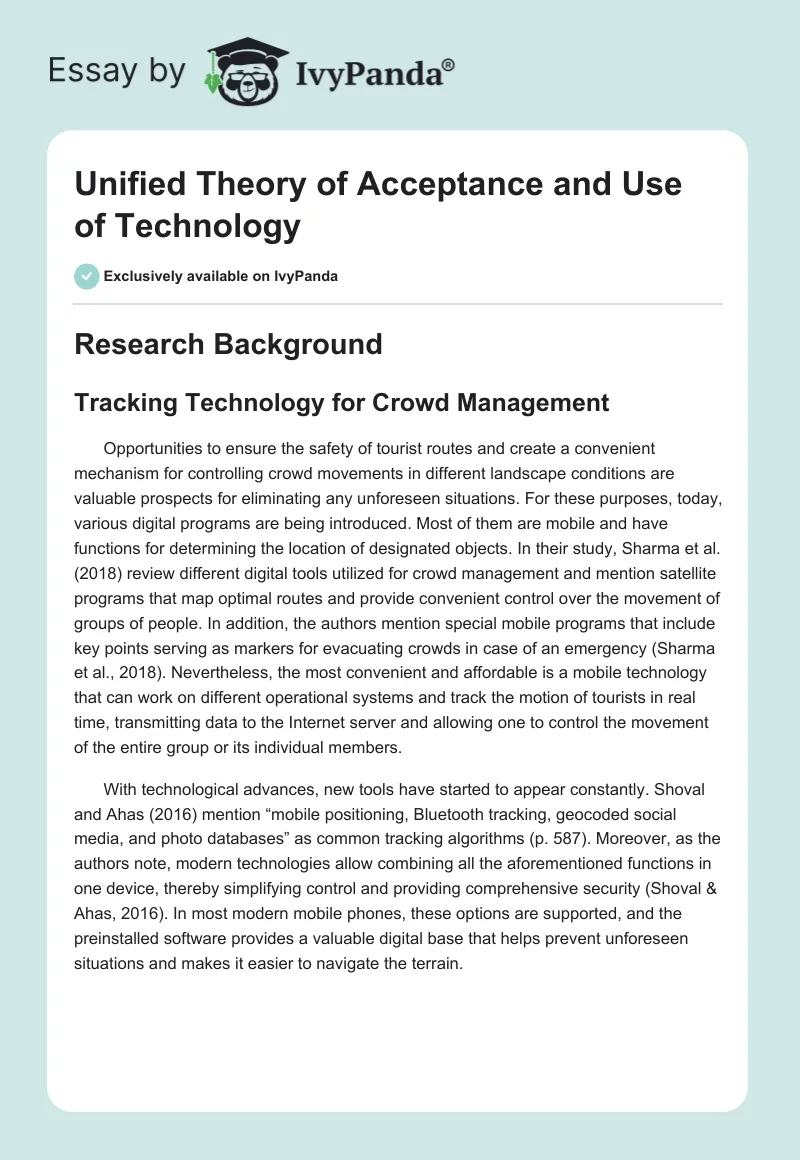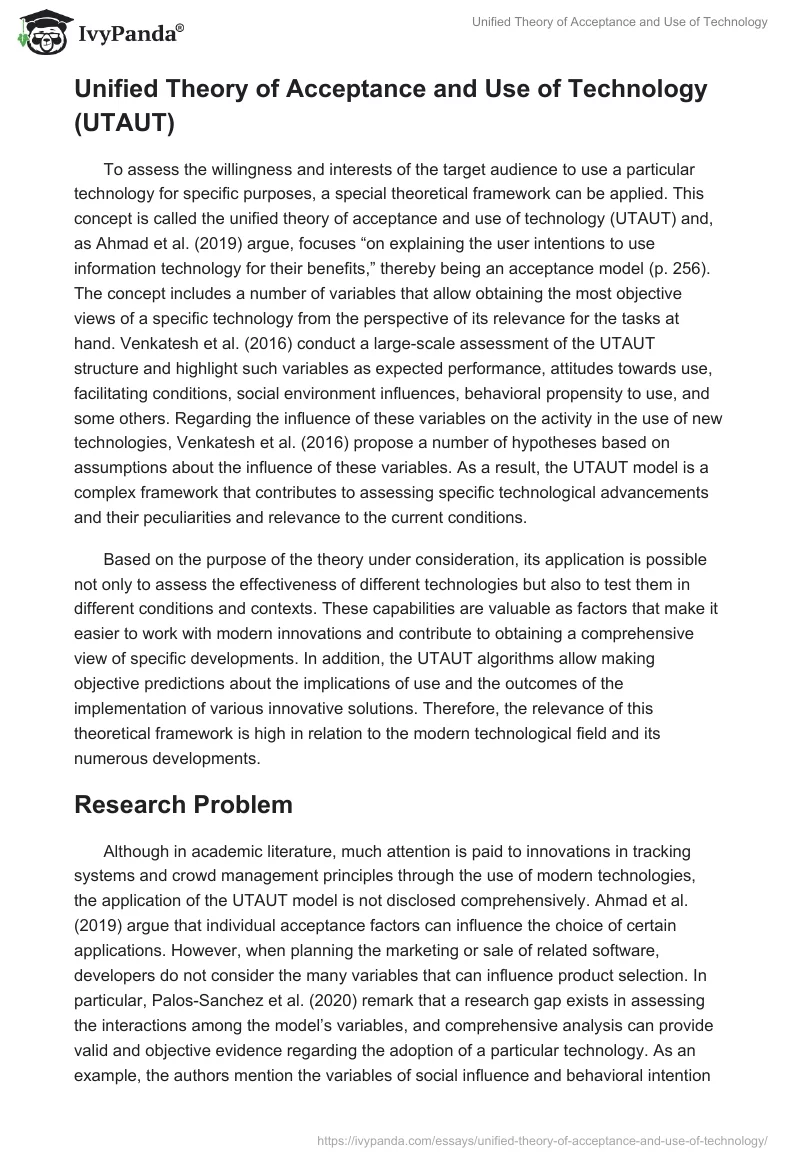Research Background
Tracking Technology for Crowd Management
Opportunities to ensure the safety of tourist routes and create a convenient mechanism for controlling crowd movements in different landscape conditions are valuable prospects for eliminating any unforeseen situations. For these purposes, today, various digital programs are being introduced. Most of them are mobile and have functions for determining the location of designated objects. In their study, Sharma et al. (2018) review different digital tools utilized for crowd management and mention satellite programs that map optimal routes and provide convenient control over the movement of groups of people. In addition, the authors mention special mobile programs that include key points serving as markers for evacuating crowds in case of an emergency (Sharma et al., 2018). Nevertheless, the most convenient and affordable is a mobile technology that can work on different operational systems and track the motion of tourists in real time, transmitting data to the Internet server and allowing one to control the movement of the entire group or its individual members.
With technological advances, new tools have started to appear constantly. Shoval and Ahas (2016) mention “mobile positioning, Bluetooth tracking, geocoded social media, and photo databases” as common tracking algorithms (p. 587). Moreover, as the authors note, modern technologies allow combining all the aforementioned functions in one device, thereby simplifying control and providing comprehensive security (Shoval & Ahas, 2016). In most modern mobile phones, these options are supported, and the preinstalled software provides a valuable digital base that helps prevent unforeseen situations and makes it easier to navigate the terrain.
Unified Theory of Acceptance and Use of Technology (UTAUT)
To assess the willingness and interests of the target audience to use a particular technology for specific purposes, a special theoretical framework can be applied. This concept is called the unified theory of acceptance and use of technology (UTAUT) and, as Ahmad et al. (2019) argue, focuses “on explaining the user intentions to use information technology for their benefits,” thereby being an acceptance model (p. 256). The concept includes a number of variables that allow obtaining the most objective views of a specific technology from the perspective of its relevance for the tasks at hand. Venkatesh et al. (2016) conduct a large-scale assessment of the UTAUT structure and highlight such variables as expected performance, attitudes towards use, facilitating conditions, social environment influences, behavioral propensity to use, and some others. Regarding the influence of these variables on the activity in the use of new technologies, Venkatesh et al. (2016) propose a number of hypotheses based on assumptions about the influence of these variables. As a result, the UTAUT model is a complex framework that contributes to assessing specific technological advancements and their peculiarities and relevance to the current conditions.
Based on the purpose of the theory under consideration, its application is possible not only to assess the effectiveness of different technologies but also to test them in different conditions and contexts. These capabilities are valuable as factors that make it easier to work with modern innovations and contribute to obtaining a comprehensive view of specific developments. In addition, the UTAUT algorithms allow making objective predictions about the implications of use and the outcomes of the implementation of various innovative solutions. Therefore, the relevance of this theoretical framework is high in relation to the modern technological field and its numerous developments.
Research Problem
Although in academic literature, much attention is paid to innovations in tracking systems and crowd management principles through the use of modern technologies, the application of the UTAUT model is not disclosed comprehensively. Ahmad et al. (2019) argue that individual acceptance factors can influence the choice of certain applications. However, when planning the marketing or sale of related software, developers do not consider the many variables that can influence product selection. In particular, Palos-Sanchez et al. (2020) remark that a research gap exists in assessing the interactions among the model’s variables, and comprehensive analysis can provide valid and objective evidence regarding the adoption of a particular technology. As an example, the authors mention the variables of social influence and behavioral intention and state that “social relationships do influence the users’ intention to use an app” (Palos-Sanchez et al., 2020, p. 25). Therefore, to evaluate the indicators of adoption of appropriate crowd management software through tracking systems, determining the correlations among the UTAUT variables is a valuable solution to bridge the research gap.
Research Theory
The Usage of UTAUT in Crowd Management
The application of UTAUT to crowd management is realized through the assessment of the available movement control mechanisms by utilizing a complex methodology with different variables. According to Ahmad et al. (2019), one of the main purposes of this model is to improve logistics productivity, in particular, perform a comprehensive analysis of routes from the perspective of safety and convenience. As the aspects influencing the quality of crowd management, one can pay attention not only to the involvement of variables for the assessment but also to some accompanying factors. In particular, Van Winkle et al. (2019) mention crowd density as one of the criteria determining the convenience of controlling people’s movement. In general, the UTAUT model contributes to registering objective data about the intentions of users regarding the use of logistics tools, as a rule, digital applications (Ahmad et al., 2019). The variability of devices and gadgets is a factor to analyze and highlight the characteristics and preferences to have an optimal picture of how crowd management is best organized. Therefore, the concept under consideration is convenient and has valuable implications for providing comprehensive logistics control, including tourist routes.
The Usage of UTAUT with Tracking Technology
One of the main advantages of using UTAUT with tracking technology is an opportunity to identify user intention to utilize specific devices. Reith et al. (2020) evaluate this model as a framework that allows finding the strongest variables that determine the choice of particular gadgets and highlighting those predictors that are relevant to a certain group of people. In addition, according to the researchers, the UTAUT framework helps identify practical implications for the use of innovations, including tracking technologies (Reith et al., 2020). The safety of tourists is an essential aspect of any excursion. At the same time, as Sharma et al. (2018) note, “in majority of events there is no provision for registering, tracking and interacting (e.g. taking feedbacks) with the visitors during the events” (p. 492). UTAUT, in turn, is a concept that makes it possible to create a stable and accurate control algorithm by obtaining credible data on all critical parameters, including the number of tourists, available devices, specific social conditions, and other significant variables. Thus, this model is utilized with tracking technologies successfully and is a valuable framework to implement.
References
Ahmad, S., Zulfiqar, M., Ghafoor, S., Kumar, P., Khan, A., Ahmad, H., Khan, A., & Shafique, M. N. (2019). Wearable technologies: The implication of united theory of acceptance and use of technology in crowdsourcing logistics. Sarhad Journal of Management Sciences, 5(2), 255-266.
Palos-Sanchez, P., Saura, J. R., & Correia, M. B. (2020). Do tourism applications’ quality and user experience influence its acceptance by tourists? Review of Managerial Science, 1-37. Web.
Reith, R., Buck, C., Eymann, T., & Lis, B. (2020). Integrating privacy concerns into the unified theory of acceptance and use of technology to explain the adoption of fitness trackers. International Journal of Innovation and Technology Management, 17(7), 2050049. Web.
Sharma, D., Bhondekar, A. P., Shukla, A. K., & Ghanshyam, C. (2018). A review on technological advancements in crowd management. Journal of Ambient Intelligence and Humanized Computing, 9(3), 485-495. Web.
Shoval, N., & Ahas, R. (2016). The use of tracking technologies in tourism research: The first decade. Tourism Geographies, 18(5), 587-606. Web.
Van Winkle, C. M., Bueddefeld, J. N., Halpenny, E. A., & MacKay, K. J. (2019). The unified theory of acceptance and use of technology 2: Understanding mobile device use at festivals. Leisure Studies, 38(5), 634-650. Web.
Venkatesh, V., Thong, J. Y., & Xu, X. (2016). Unified theory of acceptance and use of technology: A synthesis and the road ahead. Journal of the Association for Information Systems, 17(5), 328-376.


